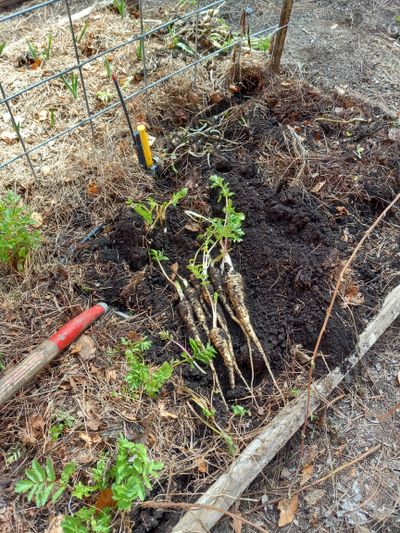Gardening: Overwinter carrots and parsnips for a sweet spring harvest

I harvested my first crop of vegetables from the garden last week. Or was it the last crop from last year? Regardless, we have a nice mess of sweet parsnips to create our favorite root bake of parsnips, carrots, potatoes, onions and garlic.
Parsnips and carrots can be overwintered in a garden bed that is covered with 3 to 4 inches of mulch in the late fall. The mulch keeps the roots frozen through the winter. In our short climate. The trick to overwintering carrots and parsnips is to start them in the spring, so they are mature at the end of the fall . Once the cold weather sets in, they won’t grow any more.
Choose a sunny planting spot that will not be disturbed through the season. Work the soil deeply so the roots can grow down easily. Plant the seeds at the end of April according to the package directions to take advantage of the cool spring. They may take several weeks to germinate so cover the bed with sheets of cardboard to keep the weeds down. Once they germinate, remove the cardboard. Carrots can be thinned to about 2 inches apart. Parsnips should be 3 inches apart. Once the tops are growing well, mulch to control weeds.
Carrots and parsnips are in the same plant family so their seeds are very small and can be tricky to plant. One way around this is to purchase pelleted seed which is seed that has a coating of clay applied to increase its size. This makes it easy to place the seeds so you don’t have to spend time thinning later. They are not easy to find but Ferry-Morse Seed offers them in its Sow Easy seed line. Territorial Seed and Johnny’s Select Seed also carry them. Check the independent garden centers locally for them or order online.
Through the summer, keep the beds evenly moist. They won’t need fertilizer; too much nitrogen causes forked or misshaped roots. One issue we are seeing locally in the last couple of years is carrot root fly which attacks the root. The flies come out early in the spring and are drawn to the distinctive odor of the carrot family. The fly lays its eggs on the shoulder of the carrot and the larvae burrow into the root. Once they are into the root, they can’t be controlled. The best way to control them is cover the planting after it germinates with light weight floating row cover or insect barrier. It is available at local garden centers.
Tip of the week: Now is the time to cut down most of your ornamental grasses except for fescues and blue oat grass. Cut the clumps down to about 8 inches high and lightly fertilize them. The foliage of blue oat grass and fescues are evergreen and need to be left. All they need is a good combing out to remove dead stems. Apply fertilizer afterwards and they are set for the season.